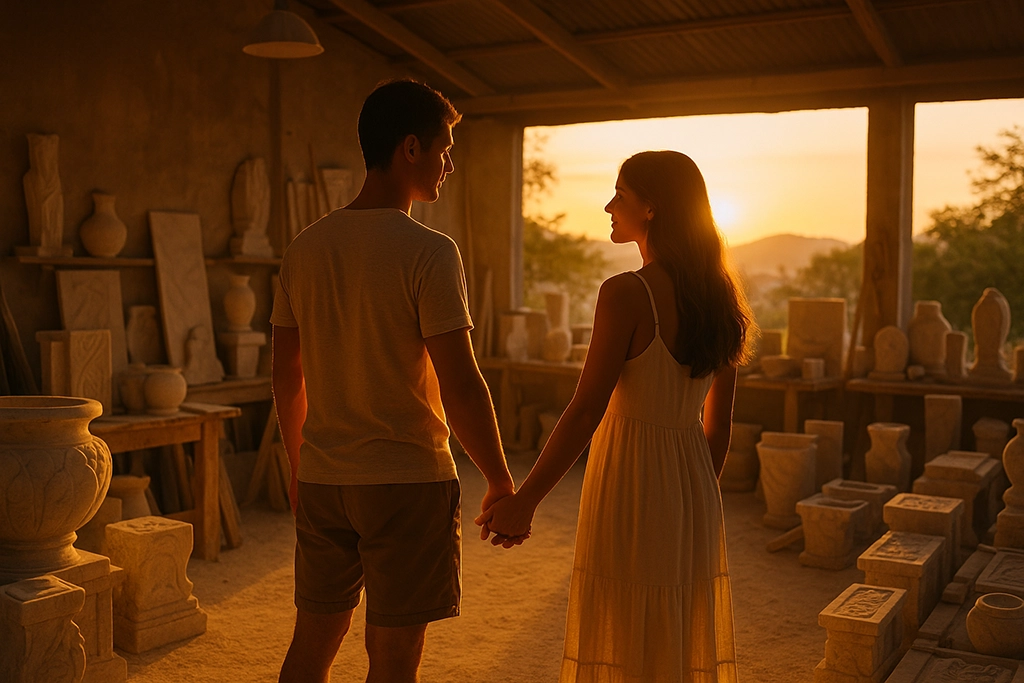
Why the Philippines is Cupid’s most popular Archipelago
Cupid has a time share here for a reason. Other locations might offer you one postcard-worthy view, but the Philippines dishes out 7,641 islands — each with unique backdrops for a love story. Picture waking up to the sound of ocean waves instead of your alarm, trading your morning commute for a wander along a beach you practically have to yourself, and ending the day with a sunset so vivid that you wonder whether someone has Photoshopped the horizon in real life. See, love here comes packaged with aquamarine seas, mountain mists, secret waterfalls, and the occasional cheeky Geico looking out from behind the blinds of your honeymoon suite.
The archipelago isn’t merely an assembly of islands; it’s a smorgasbord of romantic potential. In the morning, you might explore a sunken WWII vessel; in the afternoon, sip mountain-grown coffee surrounded by clouds; in the evening, dine on seafood so fresh it probably swam onto your plate. Whether you and your significant other are the “adventure together” kind or the “let’s hold hands and look at the view” type of couple, the Philippines has you covered — sometimes with a hand holding a mango shake in one of yours, and a plate of garlic rice in the other.
Tropical Island Escapes for Lovers
El Nido, Palawan – Love above Limestone Cliffs
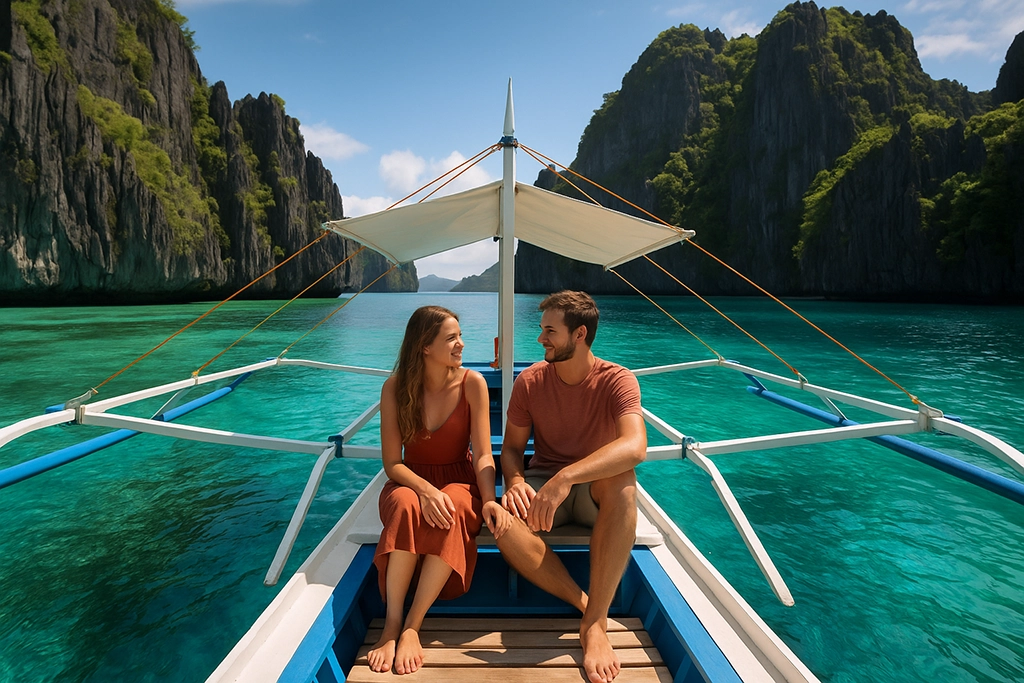
If you could dream a canvas for romance, El Nido would be the scene — looming limestone cliffs literally rising out of gin-clear waters, hidden lagoons secreted away like private nature VIP lounges, and sunsets that could wring a verse out of even the most hopeless poet from the bottom of an empty mojito glass. People come here for the magic, but they stay because around every turn is another perfect, slightly smug, Instagram shot.
Lodging Options
- Budget-Friendly: These are beachfront inns where the Wi-Fi might be coy and the hammocks copious.
- Mid-Range Resorts: Several boutique resorts feature passive edge pools, making you feel like a movie star.
- Luxury Resorts: And then there are villas on private islands where the staff knows your name, your favorite wine, and quite possibly your zodiac sign.
Whether or not you’re splurging (or pinching pennies), the romance factor is the same. Those days are best spent kayaking to hidden lagoons, hopping to islands so empty they seem to belong to you and only you, or sharing a picnic on the sand so perfectly timed with sunset you’d think it was scripted.
Culinary Romance
And then there’s the food. El Nido is seafood heaven, and what could be more romantic than fresh-off-the-grill meat of the animal variety? Picture this: You’re on a private beach, your toes in the sand, watching your lunch sizzle on an open flame as the tide murmurs a lullaby in the background.
Sample the local kinilaw — Filipino ceviche — with fish so fresh it’s barely finished gossiping about the tide schedule. For snacking between adventures, don’t pass up on roasted cashews from neighboring farms. They’re dangerously moreish, great for sharing on boat trips, or hoarding for yourself if you’re feeling wily.
Dining here tends to be an experience. Many boat tours include a “beach BBQ” stop, and your guide will emerge from the boat with a massive platter of prawns, squid, and tropical fruit that’s carved with a theatricality that might make a chef’s school proud. You will have tasted your fill of fresh pineapple, enough to become an honorary islander — and possibly, enough so much garlic rice that you’ll need a nap until the next day’s adventure.
Coron – Wreck Dives and Sunrise Snuggles
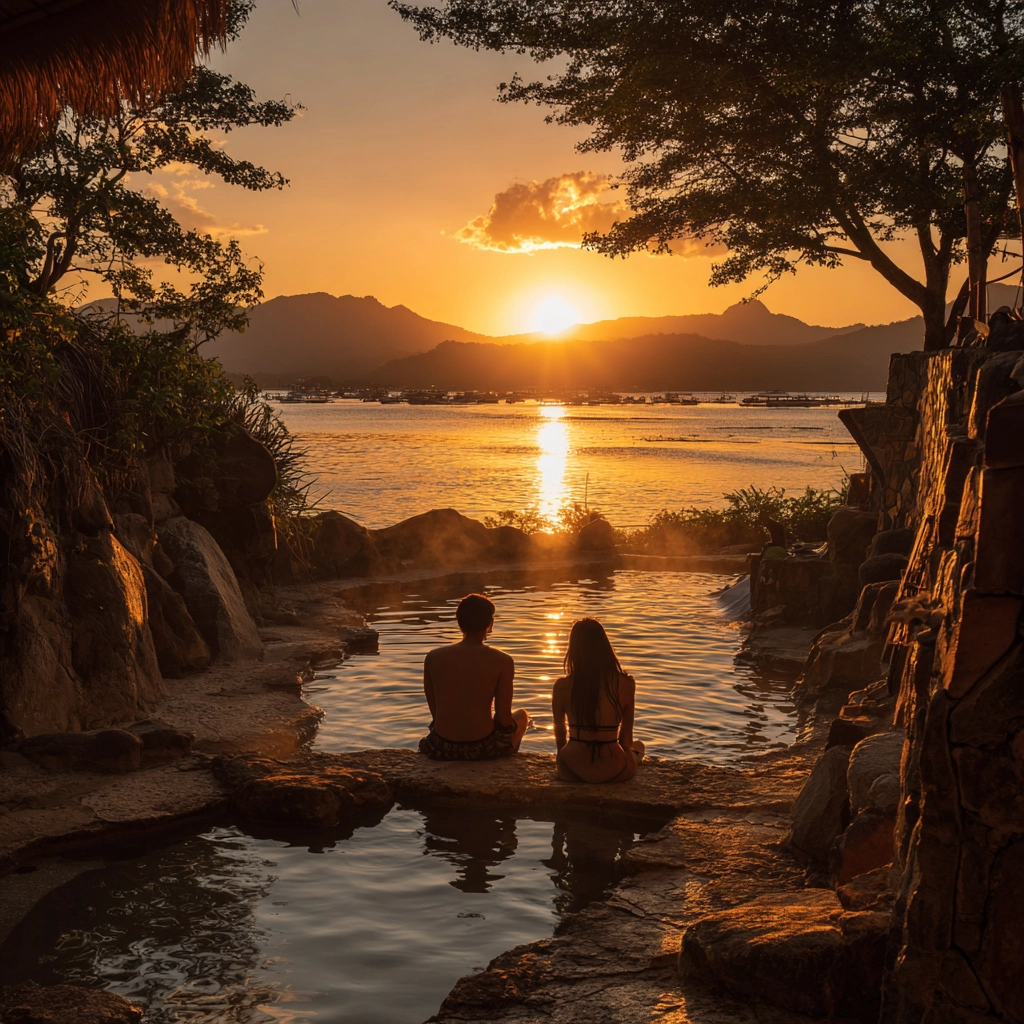
If El Nido is the glossily painted magazine cover, then Coron is the treasure map. This archipelago is one part adventure, one part romance, and just mysterious enough to make you feel like the star of your own couples’ adventure. The beaches are less crowded, the landscapes are more rugged, and the water — well, it’s so crystal clear you’ll start to question if you’ve accidentally stepped into a computer screensaver.
Accommodation Options
- Budget: Your choice of accommodation ranges from friendly guesthouses (those hammocks can be so seductive!)
- Mid-Range: Here you’ll find lakeside lodges that include spas with sunset cocktails.
- Luxury: This is where you can get villas so luxurious, you may wish to have your mail forwarded here permanently.
Days have their own rhythm here: Mornings are about diving hand-in-hand into WWII shipwrecks, afternoons soak in Maquinit Hot Springs, and evenings glide down the passage to Kayangan Lake, where you can float in water so clear it’s like swimming through glass.
Culinary Delights
The culinary pleasures here are as much an attraction as the turquoise lagoons. Begin your day with crispy danggit, a salted and sun-dried fish that’s the Filipino answer to bacon and sure to wake you up in a way espresso never could. Lunch could be a whole grilled lapu-lapu, its skin crisped and smoky, with a bowl of calamansi and soy sauce alongside. And then, there’s mango wine — sweet, a little bit floral, and just the thing to sip as the sky turns gold over Coron Bay.
Coron cuisine veers toward the fresh and unfussy, but that simplicity is deceptive. The taste comes from close access to ingredients on the island. Here, “farm-to-table” can easily become “ocean-to-boat-to-plate” in less than an hour. Despite the upheavals, though, dining with your toes in the sand is not merely optional; it’s pretty much the way things work. By the time you depart, you’ll be weighing what you miss most: the beaches or the grilled squid.
Surf, Sand, and Early Morning Sunrise Coffee Dates in Siargao
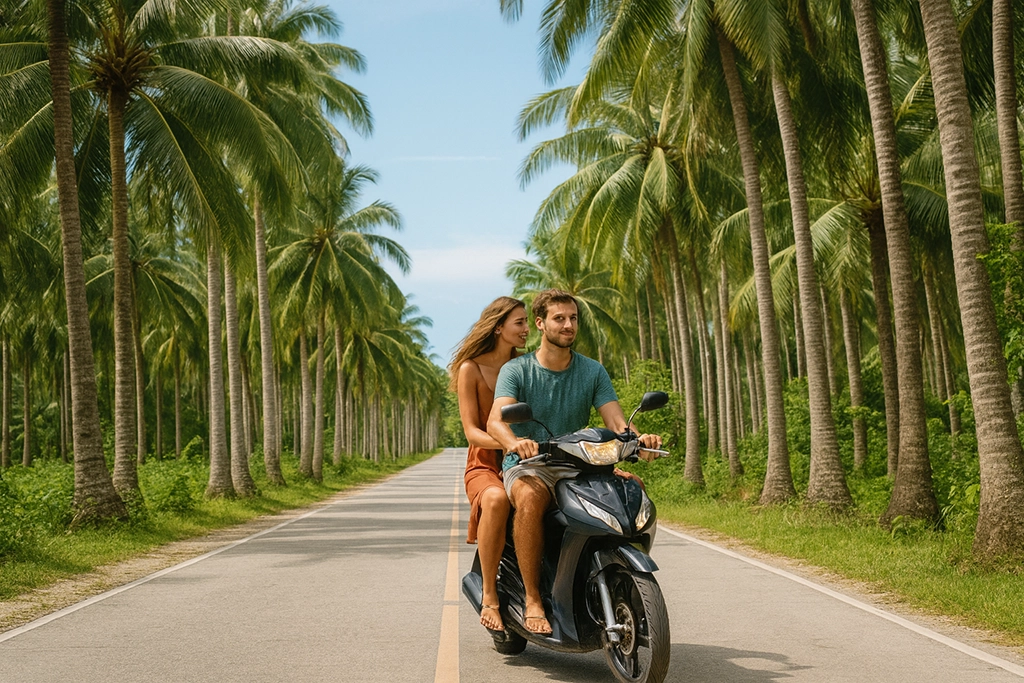
They call Siargao the surfing capital of the Philippines, but it is also the capital of “let’s just stay one more day” syndrome. It’s a bit wild, a bit hipster, and totally able to take your breath away — perhaps in a way you don’t want to (if you try to surf before you practice).
Best Places to Stay
- Budget: Check out the surf hostels when you’re in the mood to swap stories around the beer pong table.
- Mid-Range: If you prefer waking up to the sound of waves and the smell of pancakes, eco-resorts are available.
- Luxury: If you just want to do it in style, consider the designer beachfront villas if your idea of roughing it is missing your sunglasses.
By day, hire a scooter and drive along the Coconut Tree Road, go rock pool exploring at Magpupungko, or pack a picnic and head to Sugba Lagoon, where the water is so eye-poppingly beautiful that you won’t remember to Instagram it until you’re already halfway through a float.
The Local Culinary Scene
The food scene in Siargao is as diverse as its people. Breakfast could be coconut ice cream beneath the very tree on which the coconuts grow, lunch a poke bowl speckled with local tuna, while dinner could be a feast of grilled prawns so fresh you’ll wonder if they were still making friends in the ocean that morning. Pan de surf — bread in the shape of surfboards — is an excellent snack to bring on beach-hopping road trips.
The culture of the café also found a cozy home on the island, which means you can sit in a third-wave coffee shop and sip your cold brew while watching surfers take off at Cloud 9. And, for the fancy-pants, some resorts have sunset dinners ON the sand with tiki torches and wine and live acoustic music that makes you think, “Yes, we are definitely coming back here.”
Mountain Retreats and Cool-Weather Romance
Baguio – When it’s Sweater Weather and Strawberry Kisses
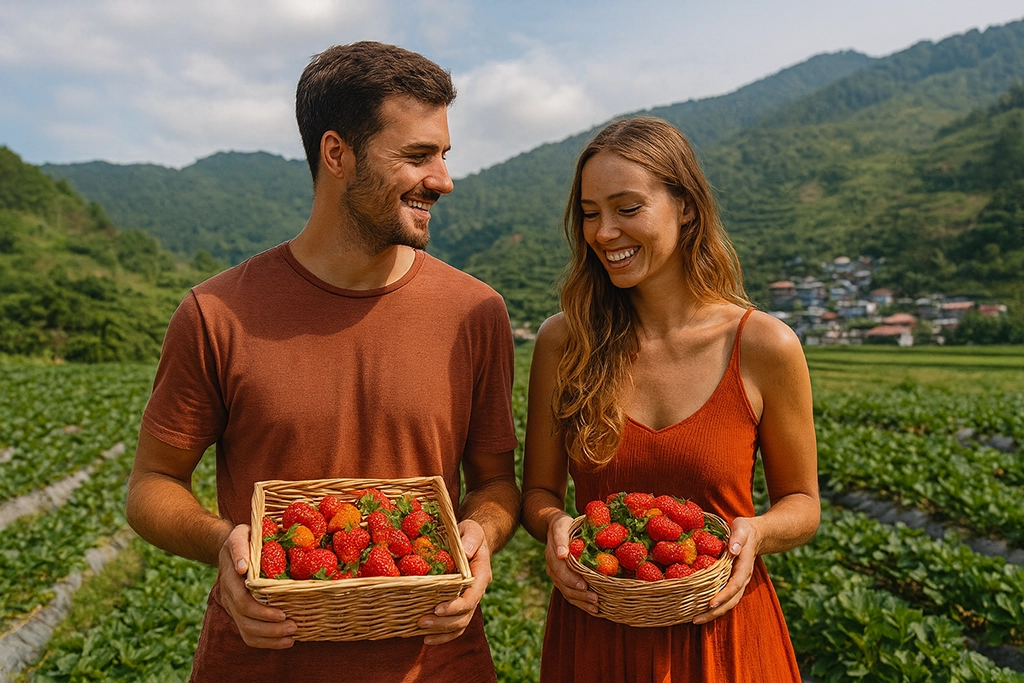
Baguio is where the Philippines swaps bikinis for cardigans. Situated 1,500 meters above sea level, the Summer Capital of the Philippines is the perfect reason to layer in your cutest matching scarves and avoid sweating through them in two minutes. The pine-scented air serves as nature’s perfume; the cool air prompts each hug to last slightly longer.
Places to Stay
Accommodation here can be as rustic or as regal as you’d like.
- Budget: Budget Bed and Breakfasts (BnBs) in Baguio are snug enough to make you feel like you’ve stepped into your lola’s mountain shack— with extra thick comforters, unlimited hot cocoa, and all.
- Mid-Range: Baguio also offers some amazing log cabins complete with fireplaces to roast late-night marshmallows.
- Luxury: The heritage mansions in Baguio will get you sipping wine under chandeliers following a four-course dinner you didn’t have to make.
The days are for slow adventures: strawberry-picking in La Trinidad, where you will “accidentally” eat more than you can put in your basket; renting a swan boat at Burnham Park as you pretend you are in an old romance film; and strolling arm in arm through the night market, arguing about whether you really need that extra knitted beanie (you do).
Dining Delights
The food is almost as famous as the view. A productive day, for me, is one bookended by two nourishing things: a bowl of congee in the morning and a cup of a sweet, silken tofu dessert known as taho. Along the streets, stores fill plastic bags with strawberry- or chocolate-flavored tofu, which is topped with little pearls of tapioca suspended in thick syrup, or fresh strawberries and whipped cream. Stroll the public market for ukoy (crispy shrimp fritters) so addictive that you may soon be eating them as, ahem, “appetizers” before breakfast. And if you’re a coffee couple, the local brews here are strong, fragrant, and great for wrapping yourself in a blanket and sitting on your balcony in the morning to watch the fog roll in.
The food world in Baguio does not shy away from excess. Good Shepherd Convent ube jam, freshly baked raisin bread, and sizzling plates of pork sisig will have you repeatedly, and permanently, in a “let’s just split one more” state of mind. And really, what’s more romantic than sharing spoonfuls of strawberry ice cream in 18-degree weather and pretending you’re somewhere in Europe?
Sagada – Above the Clouds, In Each Other’s Arms

If Baguio is like that cozy romance novel, Sagada is the indie film version — thoughtful and quiet and shot through with jaw-dropping scenery that stops you mid-sentence. The small mountain town is known for its sea of clouds, enigmatically hanging coffins, and coffee that’s so good arguments could be solved before they even begin.
Places to Rest and Relax
The rooms here are explicitly outfitted to complement the rustic-chic feel.
- Budget: The friendly homestays provide you with warm mountain hospitality coupled with home-cooked meals.
- Mid-Range: For a room with a view of pine forests from your balcony, check out the lodges of Sagada.
- Luxury: You’ll be pampered by the boutique resorts here, with spa treatments and breakfast served in bed.
Your days may begin with a predawn trip to Kiltepan Peak, which you reach just in time to see the sunrise spread colors so beautiful you will momentarily forget how early it is. Spend afternoons walking through limestone caves, clasping hands, popping out to give yourselves freshly brewed coffees at a hillside café. Nighttime is for walking deserted streets, stargazing without the glow of the city, and possibly exchanging ghost stories around the fire.
Local Specialties
And the food? Sagada is stripped down, local, and good-hearted. The coffee is worth a trip in itself — local, grown, roasted on site, and served with a view of mist rolling through the hills. The deep, savory flavors go perfectly with a glass of red wine, so serve it with etag, the region’s smoked pork delicacy. And then there’s the much-loved lemon pie — bright, tangy, and balanced with just enough sweetness to make you close your eyes and accept the warm praise.
The experience of eating in Sagada is a leisurely one: Mom-and-pop cafes serve up hearty homemade entrées that evoke recipes passed down over the generations. From vegetable stews to fresh-baked bread, each meal seems designed for sharing, ideally while slouched back in a wooden seat, legs stretched toward a crackling fire.
Cultural & Heritage Lovey Dovey Spots
Vigan – Cobblestones and Carriage Rides

If your relationship is built on love of history and carbs, Vigan is your city. It’s all cobblestone streets, Spanish-era mansions, and horse-drawn carriages that will have you convinced you’re the star of a historical romance novel (there is also definitely a lack of bad lighting and tragic plotlines).
Romantic Accommodations
You will stay in various places that serve as living museums.
- Budget: There are charming colonial guesthouses here, with creaking floors and handmade furniture.
- Mid-Range: In this category, you may also find some heritage hotels, which open onto leafy courtyards where you can have a coffee under the bougainvillea.
- Luxury: Numerous renovated mansions offer the full “old money” fantasy without the generational guilt.
Days here are about holding hands as you stroll past ancestral houses and the potter’s workshops, where you can make your own clay keepsake. In the evenings, take a kalesa (horse-drawn) ride through streets lit by lanterns, and you’ll feel like you’ve stepped into another age. And when you need a respite from those feet of yours, there is sure to be a café slinging something deep-fried and glorious.
Spanish Cuisine
And speaking of glorious, the food in Vigan has a love story all its own. Beginning with some garlicky longganisa, the local sausage so luxuriously fatty and savory it could spoil you for any other sausage. We bought our empanadas from street tenders, and it was hard to resist a flaky, meat-and-egg-stuffed pastry that was crispy on the outside and warm and homey within—kind of like a good relationship. For dessert, pick up a slice of bibingka, a rice cake baked in clay ovens and eaten warm, as the night air chills.
Dining in Vigan is often accompanied by a scene — either the lively Plaza Salcedo or a hushed, lantern-lit courtyard. Either way, you’ll be dining surrounded by centuries-old buildings clamoring to tell you stories of love, politics, and perhaps a scandalous family squabble.
Intramuros, Manila – Love in the Time of Fortresses

If Vigan is the living museum, then Intramuros is the chapter where the plot thickens. This ancient walled Spanish city at the center of Manila has withstood invasions, earthquakes, and centuries of gossip. For couples, it’s a perfect date night that travels through time without the difficulty of explaining why you’re from the future.
Romantic Hideouts
- Budget: Around the gates themselves are artsy hostels where travelers can enjoy chatting over local beer, sharing secrets with other backpackers.
- Mid-range: Boutique hotels in restored colonial buildings offer a charming setting with cobblestone streets to wake up to.
- Luxury: Within walking distance is The Manila Hotel — pure luxury, featuring chandeliers, grand ballrooms, and a staff that makes you feel like visiting royalty (only without the tabloid scandals).
A romantic day onstage here: could start with a stroll along the city’s walls, hand in hand as you watch the flivvers roll along below.” Go to Fort Santiago and pretend to be blighted lovers making their escape through its stone walls. Also, pop into San Agustin Church, not because of its beauty (though it is), but because you want to silently judge the floral arrangements, as if you’re planning your own wedding. And as the sun begins to dip, catch it from a vantage point overlooking Manila Bay; it even outshines the kaleidoscopic neon lights of the city.
Local Dining Options
But history is not just what Intramuros deals in; it’s what it dishes up on a plate. Begin with a tall glass of artisan tsokolate, whisked in a batirol to a thickness that constitutes a meal. Split a halo-halo at a heritage café, the tower of shaved ice, fruits, and leche flan challenging you to lick it together. Bring the date here for dinner for a spread of Spanish Filipino classics — paella, callos, lengua — in candlelit dining rooms that look like they’ve been waiting for your date night for decades.
Eating here is as much about vibe as flavor. Whether you’re clinking glasses in a grand dining hall or splitting a plate of bibingka from a street vendor, in Intramuros, the romance wraps you as easily as the history does.
Hidden Gems for the “We Don’t Like Crowds” Couple
Camiguin – The Island Born of Fire
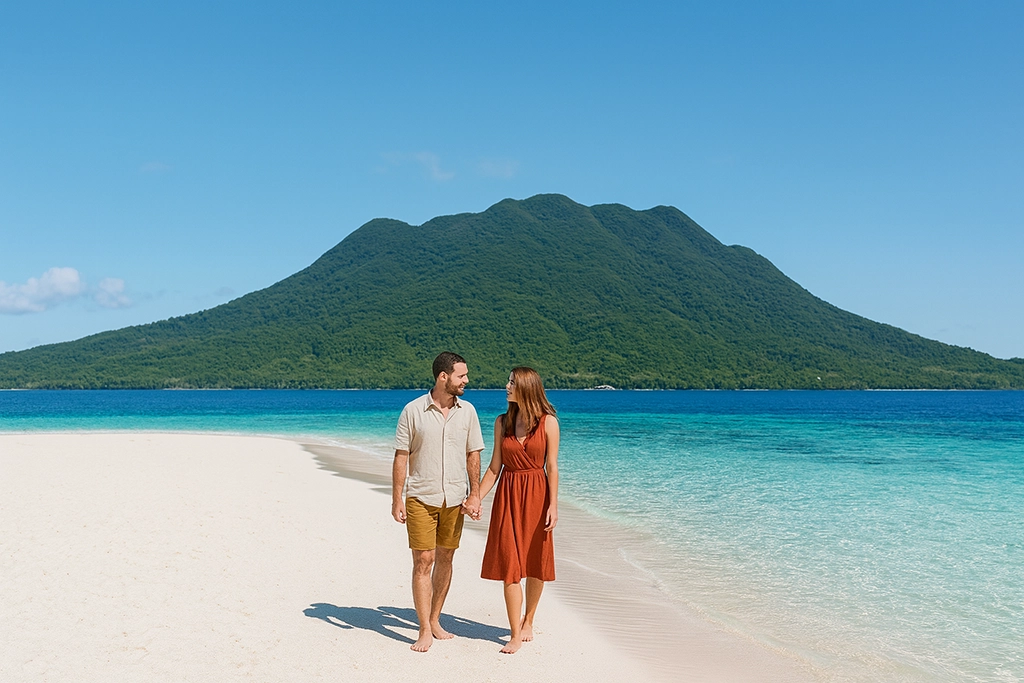
Interestingly, the entire island of 238 square kilometers is volcanic. Camiguin is a testament to the fact that the best things come in small packages. The island province is hardly a dot on the map, yet it contains more romance by the square kilometer than most entire nations. Known as “The Island Born of Fire” due to its volcanic past, Camiguin offers a range of activities, including hot springs to soak in, waterfalls to chase, and beaches so quiet you’ll feel as if you’ve hired out the entire island for your visit.
Available Accommodations
- Budget: These stays are small, family-operated beach-front inns that the owner of the hotel may run, and he might happen to give you some extra mangos just because he thinks you’re a swell guy.
- Mid-range: Along the cliff are the types of resorts where the views from the infinity pool are Photoshopped, you swear.
- Luxury: These are spa retreats offering complete seclusion — ideal when you’re in “Do Not Disturb” mode.
A day in Camiguin can be a deliciously spontaneous experience. Drift in the crystal shallows of the White Island sandbar, hike to Katibawasan Falls, soak in a natural hot spring until your fingers prune. The air carries a faint scent of the sea and of something sweet, which brings us to … the food.
The Culinary Scene
Camiguin’s culinary calling card is pastel—a soft bun filled with yema (custard) so sweet it should come with a warning label. These little pillows of happiness are perfect for sharing, but let’s be honest, you’ll probably eat yours before offering a bite. Then there’s surol, a hearty native chicken stew, ideal for a quiet dinner on a rainy night. And if you visit during lanzones season, prepare to eat your body weight in these golden, sweet-tart fruits, possibly while sitting on the balcony watching the sun sink into the sea.
Meals here often come with a view, whether it’s the fiery glow of a volcano at sunset or the gentle lap of waves against the shore. In Camiguin, even a simple grilled fish dinner feels like an event when it’s just you, your partner, and the sound of the ocean.
Romblon – Marbles, Beaches, and Not a Tour Bus in Sight

It’s the sort of place you almost don’t want to broadcast, in that part of its charm is that not very many people are there. It’s most famous for its marble quarries, but a playground of powdery beaches, secret coves, and diving spots where you’re more likely to share the water with a school of fish than with a crowd.
Where to Stay
- Budget: To manage your funds, consider beach cottages with hammocks.
- Mid-range: Here, you’ll find resorts that include free kayaks.
- Luxury: Indulge in private villas with a personal chef to cook dinner while the sun sets on the horizon.
The day inches along here in the best possible way. Paddle out to an empty stretch of sand on a kayak, snorkel in reefs so clearly you want to propose underwater, or wander through marble workshops to pick out a heart-shaped keepsake. And while the panoramas are stunning, Romblon’s food scene is subtly remarkable.
Local Culinary Favorites
Fresh seafood is the lifeblood of the island — although you will likely find it grilled, baked, or swimming in sinigang na isda (sour soup) rather than on bread. There are plenty of coconut-based desserts, from the creamy macaroons to the sticky rice cakes wrapped in banana leaves. And for something sweet to bring home, pick up a bag (or three) of Martha’s homemade peanut brittle at the market.
I love that dining in Romblon is remarkably unassuming. You could be sitting at a plastic table beneath a thatched roof, eating the best crab of your life, a sea breeze ruffling your hair, your companion lifting a beer to you in a wordless toast, to the new favorite place.
The Best Time to Travel – Dry Season vs. Rainy Season for Lovers
Deciding when to visit the Philippines is to some degree akin to deciding upon a wedding date — do you want flawless weather and higher prices, or a bit of unpredictability and the joy of having the place (almost) all to yourselves?
Dry Season
From November to May, the country turns it up to 11. The skies are bluer than on a newly Photoshopped travel brochure, the seas are still, and evening sunsets appear filtered for romance. This is peak time for island hopping at El Nido, Coron, and Siargao. Snorkel without the water churning into a washing machine, hike to mountain viewpoints without dodging raindrops, and tour cobblestone streets without soaking your shoes. The trade-off? Everybody has the same idea. Beaches are busier, hotels are lacking discounts, and landing a dinner reservation at that ‘you-must-try-it’ restaurant may require a little pre-scheduling and sweet-talking.
Dry season in the uplands has its own charms. And in Baguio and at Sagada, the weather is cool and clear, ideal for leisurely walks through the pine trees, coffee dates with a view, and actual sweater weather (a rarity in the tropics). Even the heritage cities, Vigan and Intramuros, appear to gleam a bit brighter, their old stone walls absorbing the sun. But again — if peace and tranquility are what you’re after, you’ll have to work for it.
Rainy Season
June to October is when the love affair with cooking really takes off. True, you may end up getting drenched, but tropical rain is magical when you’re watching it, nice and dry, from the secure balcony of your own room, wrapped in a blanket and cradling something warm (or, you know, alcoholic). Prices go down, the crowds thin out, and the locals have a little more time to chat. The landscapes become lush and green, and the waterfalls are in full force; moody skies make for dramatic photographs — ideal for couples who like their romance with a side of drama.
And then there’s the wild card: typhoons. They can reroute your ferry, delay your flights, or leave you marooned in one place for a few days. But if you’re the type of couple that can go from “we’re stuck here” to “let’s order room service and play cards until 2 a.m.,” the rainy season might be a match made in heaven. And frankly, there’s no better excuse for not getting out of bed until after noon than “the weather made us do it.”
Key Takeaways
The Philippines isn’t one romantic destination — it’s a choose-your-own-adventure love story. Need unlimited sunshine and days at the beach? Book in the dry season. More of a fan of cozy afternoon light, foliage, and fewer people photobombing your couple shots? The rainy season’s your friend. All budgets are catered for, from cute guesthouses to swish villas that’ll make your buds back home question why they’re slaving away for money. And each region has its own signature dish that could soon become your shared weakness.
Whether you prefer sunrise hikes, sunset sails, or midnight feasts in an unfamiliar city, you’ll get it here with an added side of warmth, and not just from the sun, but from the people who live in these islands.
FAQs
1. Where’s the most romantic place in the Philippines? Well, it is just how you like it! El Nido for sunsets and seclusion, Sagada for misty mornings, Vigan for old-world charm.
2. Which destinations have private villas?
You can find them in El Nido, Coron, Siargao, Camiguin, and even some restored mansions in Vigan. Just the thing for avoiding awkward small talk with strangers.
3. How much should I budget for a week-long trip, and what type of trip can you suggest?
For two: On a budget, around $500; midrange, $1,200; the sky’s the limit (but the champagne’s free!).
4. Is the mountain escape as romantic as the beach escape?
Absolutely. Beaches are for sunsets and swims; mountains, for sunrises and snuggles. It’s another kind of magic.
5. What are the least crowded spots?
Camiguin and Romblon would be your best bets. You might even have an entire beach to yourselves — depending on how you feel about sharing the beach with the local fishermen.
6. Do I need to reserve everything in advance?
Dry, yes — unless you enjoy explaining to your partner why you spent the night on the beach. Rainy season, you can play it by ear.
Other Articles that may be of Interest
You may also find the following articles interesting.
- Easy & Scenic Hikes in the Philippines for Nature Lovers
- You, a Hammock, and 20 Reasons to Fall in Love with the Visayas
Suggestions For Lodging and Travel
Lodging is widely available throughout the Philippines. However, you may want to consider getting assistance booking tours to some of the Philippines’ attractions. I’ve provided a few local agencies that we’ve found to be very good for setting up tours. For transparency, we may earn a commission when you click on certain links in this article, but this doesn’t influence our editorial standards. We only recommend services that we genuinely believe will enhance your travel experiences. This will not cost you anything, and I can continue to support this site through these links.
Local Lodging Assistance
- Guide to the Philippines: This site specializes in tours throughout the Philippines, offering flexibility in scheduling and competitive pricing. I highly recommend them for booking local arrangements for a trip like this one. You can book flights and hotels through the Expedia link provided below.
- Hotel Accommodations: I highly recommend The Manila Hotel for a stay in Manila. I stay here every time I travel to the Philippines. It is centrally located, and many attractions are easily accessible from there. Intramuros and Rizal Park are within walking distance. I have provided a search box below for you to use to search for hotels (click on “Stays” at the top) or flights (click on “Flights” at the top). This tool will provide me with an affiliate commission (at no additional cost to you).
- Kapwa Travel is a travel company focused on the Philippines. It specializes in customizing trips to meet customers’ needs.
- Tourismo Filipino is a well-established company that has been operating for over 40 years. It specializes in tailoring tours to meet customers’ needs.
- Tropical Experience Travel Services – Tours of the Philippines: This company offers a range of tour packages, allowing you to tailor your trip to your preferences.
Lastly, we recommend booking international travel flights through established organizations rather than a local travel agent in the Philippines. I recommend Expedia.com (see the box below), the site I use to book my international travel. I have provided a search box below for you to use to search for flights (click on “Flights” at the top) or Hotels (click on “Stays” at the top). This tool will provide me with an affiliate commission (at no cost to you).